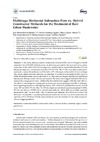Please use this identifier to cite or link to this item:
https://accedacris.ulpgc.es/jspui/handle/10553/73629
| Title: | Multistage horizontal subsurface flow vs. hybrid constructedwetlands for the treatment of raw urban wastewater | Authors: | Herrera-Melián, José Alberto Mendoza-Aguiar, Mónica Guedes Alonso, Rayco García-Jiménez, Pilar Carrasco-Acosta, Marina Ranieri, Ezio |
UNESCO Clasification: | 330810 Tecnología de aguas residuales | Keywords: | Gravel Horizontal Flow Organic Mulch Sand Shallow Constructed Wetland, et al |
Issue Date: | 2020 | Journal: | Sustainability (Switzerland) | Abstract: | In this study, pilot-scale hybrid constructed wetlands (CWs) and multistage horizontal subsurface flow CWs (HF CWs) have been studied and compared for the treatment of raw urban wastewater. In the hybrid CWs, the first stage was a mulch-based horizontal subsurface flow CW and the second stage was a vertical subsurface flow CW (VF CW). The VF CWs were used to determine if sand could improve the performance of the hybrid CW with respect to the mulch. In the multistage HFs, mulch, gravel and sand were used as substrates. The effect of water height (HF10: 10 cm vs. HF40: 40 cm) and surface loading rate (SLR: 12 vs. 24 g Chemical Oxygen Demand (COD)/m2d) has been studied. The results show that the use of sand in the vertical flow stage of the hybrid CW did not improve the average performance. Additionally, the sand became clogged, while the mulch did not. The effect of water height on average pollutant removal was not determined but HF10 performed better regarding compliance with legal regulations. With a SLR of 12 g COD/m2d, removals of HF10 were: 79% for COD, 75% for NH4+-N, 53% for dissolved molybdate-reactive phosphate-P (DRP), 99% for turbidity and 99.998% for E. coli and total coliforms. When SLR was doubled, removals decreased for NH4+-N: 49%, DRP:-20%, E coli and total coliforms: 99.5-99.9%, but not for COD (85%) and turbidity (99%). Considering the obtained results and the simplicity of the construction and operation of HFs, HF10 would be the most suitable choice for the treatment of raw urban wastewater without clogging problems. | URI: | https://accedacris.ulpgc.es/handle/10553/73629 | ISSN: | 2071-1050 | DOI: | 10.3390/su12125102 | Source: | Sustainability (Switzerland) [EISSN 2071-1050], v. 12, 5102, (Junio 2020) |
| Appears in Collections: | Artículos |
SCOPUSTM
Citations
18
checked on Jun 8, 2025
WEB OF SCIENCETM
Citations
15
checked on Jun 8, 2025
Page view(s)
372
checked on May 31, 2025
Download(s)
291
checked on May 31, 2025
Google ScholarTM
Check
Altmetric
Share
Export metadata
Items in accedaCRIS are protected by copyright, with all rights reserved, unless otherwise indicated.
